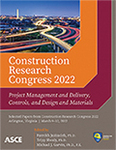Digital Technology in Architecture, Engineering, and Construction (AEC) Industry: Research Trends and Practical Status toward Construction 4.0
Publication: Construction Research Congress 2022
ABSTRACT
Construction 4.0 represents the exploration of new technologies in the architecture, engineering, and construction (AEC) industry. The development of digital technologies is rapid and the adoption of them significantly impacts construction projects, for example, leading to a reduction in change orders, better decision making, and improvements in quality of work. However, stakeholders may find it challenging to determine the promising technologies within the context of the AEC industry. This paper presents an exploratory study to investigate the potentially applicable technologies and their research and practice trends in the AEC industry. A scoping review was the method utilized to perform a quantitative analysis of over five thousand journals papers published from 2010 onward based on two academic databases (Scopus and CNKI). The results present the top 10 construction 4.0 technologies, including building information modelling (BIM), artificial intelligence (AI), 3D printing, machine learning, internet of things (IoT), geographic information systems (GIS), virtual reality (VR), big data, robotics, and augmented reality (AR). Subsequently, 145 industry professionals were invited to select the most used construction 4.0 technologies in their projects via a questionnaire survey. Mobile devices, BIM, and Digital signature are mostly adopted on-site. The findings of this study can enhance the awareness of stakeholders toward construction 4.0 technologies and may help them make better decisions in selecting and implementing the promising technologies.
Get full access to this article
View all available purchase options and get full access to this chapter.
REFERENCES
CCIA (China Construction Industry Association). (2021). Statistical Analysis of Construction Industry Development in 2020. <http://www.zgjzy.org.cn/>(accessed 5 May 2021).
Craveiroa, F., Duartec, J. P., Bartoloa, H., and Bartolod, P. J. (2019). Additive manufacturing as an enabling technology for digital construction: A perspective on Construction 4.0. sustainable development, 4, p.6.
Delgado, J. M. D., Oyedele, L., Ajayi, A., Akanbi, L., Akinade, O., Bilal, M., and Owolabi, H. (2019). “Robotics and automated systems in construction: Understanding industry-specific challenges for adoption.” Journal of Building Engineering, 26, p.100868.
Duballet, R., Baverel, O., and Dirrenberger, J. (2017). “Classification of building systems for concrete 3D printing.” Automation in Construction, 83, pp.247–258.
Guo, F., Jahren, C. T., and Turkan, Y. (2018). “Electronic Document Management Systems for the Transportation Construction Industry.” International Journal of Construction Education and Research, 17(1), pp.52–67.
Gupta, R., Tanwar, S., Tyagi, S., and Kumar, N. (2019). “Tactile internet and its applications in 5g era: A comprehensive review.” International Journal of Communication Systems, 32(14), p.e3981.
Khanna, A., and Kaur, S. (2019). “Evolution of Internet of Things (IoT) and its significant impact in the field of Precision Agriculture.” Computers and electronics in agriculture, 157, pp.218–231.
Levac, D., Colquhoun, H., and O’Brien, K. K. (2010). “Scoping studies: advancing the methodology.” Implementation science, 5(1), pp.1–9.
Li, X., Yi, W., Chi, H. L., Wang, X., and Chan, A. P. (2018). “A critical review of virtual and augmented reality (VR/AR) applications in construction safety.” Automation in Construction, 86, pp.150–162.
Luo, H., Liu, J., Li, C., Chen, K., and Zhang, M. (2020). “Ultra-rapid delivery of specialty field hospitals to combat COVID-19: Lessons learned from the Leishenshan Hospital project in Wuhan.” Automation in Construction, 119, p.103345.
Martinez, J. G., Gheisari, M., and Alarcón, L. F. (2020). “UAV integration in current construction safety planning and monitoring processes: Case study of a high-rise building construction project in Chile.” Journal of Management in Engineering, 36(3), p.05020005.
Metro, K., Harper, C., and Bogus, S. M. (2021). “Factors Affecting Workforce Resilience in Public Transportation Agencies.” Journal of Management in Engineering, 37(4), p.04021018.
National Bureau of Statistics. (2021). China National Economic and Social Development Statistics Bulletin 2020. <https://data.stats.gov.cn/>(accessed 5 May 2021).
Oesterreich, T. D., and Teuteberg, F. (2016). “Understanding the implications of digitization and automation in the context of Industry 4.0: A triangulation approach and elements of a research agenda for the construction industry.” Computers in industry, 83, pp.121–139.
Pan, Y., and Zhang, L. (2021). “Roles of artificial intelligence in construction engineering and management: A critical review and future trends.” Automation in Construction, 122, p.103517.
Pärn, E. A., and Edwards, D. J. (2017). “Conceptualizing the FinDD API plug-in: A study of BIM-FM integration.” Automation in Construction, 80, pp.11–21.
Rashidi, M., Mohammadi, M., Sadeghlou Kivi, S., Abdolvand, M. M., Truong-Hong, L., and Samali, B. (2020). “A decade of modern bridge monitoring using terrestrial laser scanning: Review and future directions.” Remote Sensing, 12(22), p.3796.
Sepasgozar, S. M., Davis, S. R., Li, H., and Luo, X. (2018). “Modeling the implementation process for new construction technologies: Thematic analysis based on Australian and US practices.” Journal of Management in Engineering, 34(3), p.05018005.
Tang, N., Hu, H., Xu, F., and Zhu, F. (2019). “Personalized safety instruction system for construction site based on internet technology.” Safety science, 116, pp.161–169.
Tang, S., Shelden, D. R., Eastman, C. M., Pishdad-Bozorgi, P., and Gao, X. (2019). “A review of building information modeling (BIM) and the internet of things (IoT) devices integration: Present status and future trends.” Automation in Construction, 101, pp.127–139.
Tavares, P., Costa, C. M., Rocha, L., Malaca, P., Costa, P., Moreira, A. P., Sousa, A., and Veiga, G. (2019). “Collaborative welding system using BIM for robotic reprogramming and spatial augmented reality.” Automation in Construction, 106, p.102825.
Tixier, A. J. P., Hallowell, M. R., Rajagopalan, B., and Bowman, D. (2016). “Application of machine learning to construction injury prediction.” Automation in construction, 69, pp.102–114.
Zagvozda, M., Dimter, S., Moser, V., and Barišić, I. (2019). “Application of GIS technology in pavement management systems.” Građevinar, 71(04.), pp.297–304.
Zhao, X., Zuo, J., Wu, G., and Huang, C. (2019). “A bibliometric review of green building research 2000–2016.” Architectural Science Review, 62(1), pp.74–88.
Information & Authors
Information
Published In
History
Published online: Mar 7, 2022
Authors
Metrics & Citations
Metrics
Citations
Download citation
If you have the appropriate software installed, you can download article citation data to the citation manager of your choice. Simply select your manager software from the list below and click Download.
